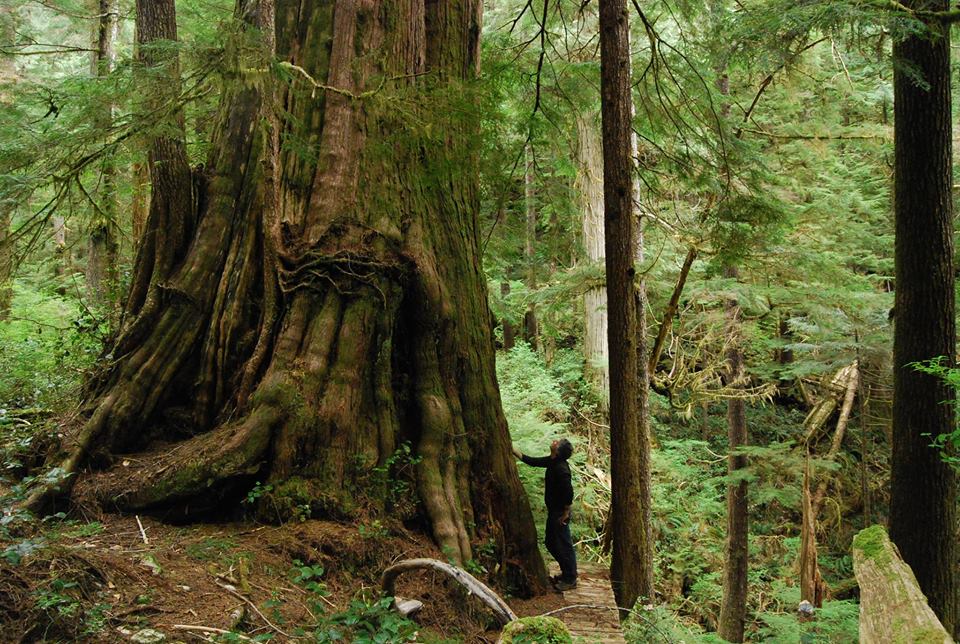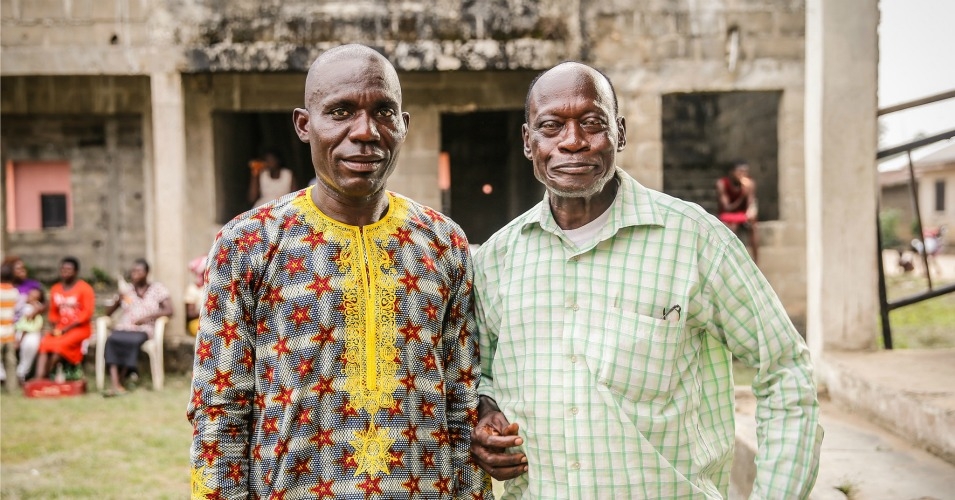
by DGR Colorado Plateau | Dec 26, 2015 | Lobbying, Toxification
Featured Image: Alali Efanga & Chief Fidelis Oguru from Oruma, two plaintiffs in the Dutch court case against Shell. (Photo: Milieudefensie/flickr)
In a potentially precedent-setting ruling, a Dutch court said Friday that Royal Dutch Shell may be held liable for oil spills at its subsidiary in Nigeria—a win for farmers and environmentalists attempting to hold the oil giant accountable for leaks, spills, and widespread pollution.
The ruling by the Court of Appeals in the Hague, which overturns a 2013 decision in favor of Shell, allows four Nigerian farmers to jointly sue the fossil fuels corporation in the Netherlands for causing extensive oil spills in Nigeria.
The scars of those disasters are still visible in the fields and fishing ponds of three Nigerian villages. In one village, drinking water has been rendered non-potable, while in another, an entire mangrove forest has been destroyed.
Alali Efanga, one of the Nigerian farmers who, along with Friends of the Earth Netherlands, brought the case against Shell, said the ruling “offers hope that Shell will finally begin to restore the soil around my village so that I will once again be able to take up farming and fishing on my own land.”
Beyond that, the court’s decision “is a landslide victory for environmentalists and these four brave Nigerian farmers who, for more than seven years, have had the courage to take on one of the most powerful companies in the world,” said Geert Ritsema, campaigner at Friends of the Earth Netherlands. “This ruling is a ray of hope for other victims of environmental degradation, human rights violations, and other misconduct by large corporations.”
Indeed, as Amnesty International researcher Mark Dummett said in advance of the ruling: “This case is especially important as it could pave the way for further cases from other communities devastated by Shell’s negligence.”
“There have been thousands of spills from Shell’s pipelines since the company started pumping oil in the Niger Delta in 1958,” Dummett said, “with devastating consequences for the people living there.”
Decrying the “incredible levels of pollution” caused by the activities of Shell and its subsidiaries, environmentalists Vandana Shiva and Nnimmo Bassey said at a media briefing in July that “weekends in Ogoniland are marked by carnivals of funerals of people in their 20s and 30s.”
Citing a 2011 United Nations Environmental Programme assessment, they noted that in over 40 locations tested in Ogoniland, the soil is polluted with hydrocarbons up to a depth of 5 meters and that all the water bodies in the region are polluted.
The UN report, they said, also found that in some places the water was polluted with benzene, a known carcinogen, at levels 900 above World Health Organization standards. “With life expectancy standing at about 41 years, the clean up of Ogoniland is projected to require a cumulative 30 years to clean both the land and water,” they said.
In another historic victory for the plaintiffs, the Hague court on Friday also ordered Shell to give the farmers and environmental activists supporting their case access to internal documents that the court said could shed more light on the case.
Channa Samkalden, counsel for the farmers and Friends of the Earth, said it was “the first time in legal history that access to internal company documents was obtained in court…This finally allows the case to be considered on its merits.”
The court will continue to hear the case in March 2016.
This work is licensed under a Creative Commons Attribution-Share Alike 3.0 License
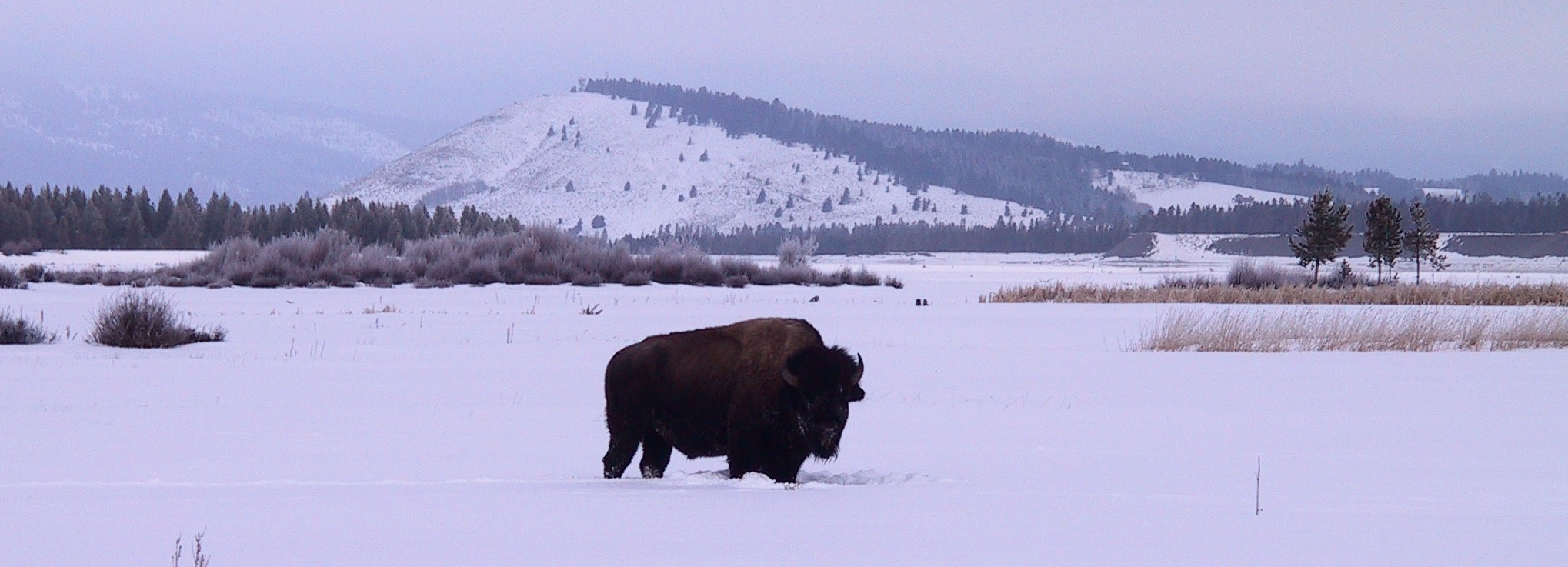
by DGR Colorado Plateau | Dec 24, 2015 | Listening to the Land, Lobbying
By Stephany Seay / Buffalo Field Campaign
Featured image: Hundreds of wild buffalo will no longer be harassed or otherwise harmed on the Horse Butte peninsula, seen in the distance here. Photo by Buffalo Field Campaign.
Yesterday, Montana Governor Steve Bullock issued his final decision on year-round habitat for wild bison in Montana, and Buffalo Field Campaign is very pleased to announce that after more than eighteen years of fighting for wild buffalo to freely roam Horse Butte, we have finally achieved this significant victory! As many of you know, Horse Butte is part of what we have been pressing for since the beginning of our campaign, and we are inclined to celebrate this achievement as the victory that it is; indeed, it may be the biggest victory we have had! It took nearly two decades of hard work in the field, in the courts, and in the policy arena to accomplish this, and it demonstrates how perseverance pays off, and how we must never give up.
This victory is a result of endless pressure, being endlessly applied by BFC, by you our dedicated supporters, by the incredible and active residents of Horse Butte, and by the buffalo themselves who consistently demonstrate resistance, persistence, and endurance. Another boon granted the buffalo is that bull bison — but only bulls — will be given year-round habitat in the Gardiner Basin. Please take a little time to celebrate this victory, as it has been hard-earned by each of you. Thank you to everyone who has been with us for the buffalo, making our work possible.
As we bask in this triumph, we cannot let down our guard. We must strengthen our resolve to continue fighting for wild buffalo and their right to roam the lands that are their birthright. We have many difficult battles yet to win. A closer look at Governor Bullock’s decision shows us that the buffalo are still in grave danger from livestock industry interests and the government agencies that serve them.
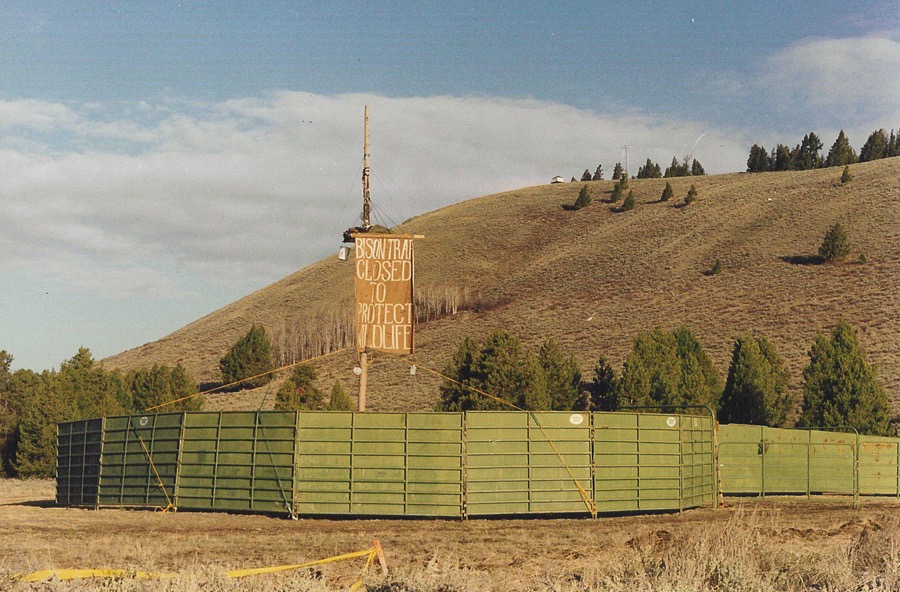
In 2004, the courageous and passionate Akiva Silver occupied the Horse Butte bison trap, saving many buffalo from being captured and shipped to slaughter. In 2008, the trap was again occupied by another brave individual, and the Montana Department of Livestock have not set it up since, nor will they ever again. Buffalo Field Campaign photo by Chris Rota.
Even the decision to grant buffalo year-round habitat on Horse Butte has its devilish details, mainly in the form of a population cap: during fall and winter approximately 450 buffalo will be allowed to live there; during the spring that number rises to 600, which is terrific timing since that’s when the large herds come to Horse Butte for calving season; but by July the government will allow only 250 buffalo to remain. From reviewing the Governor’s decision, it appears that, should there be more than 250 buffalo on Horse Butte by summer, hazing would not begin until then, which is about six weeks later than hazing has been taking place in recent years. While our ultimate goal is to put an end to all hazing, this means that wild buffalo will finally have the opportunity to make their own choices about when or whether to migrate into Yellowstone for the summer months. It will be an awesome gift to learn what they will do directly from the buffalo.
The deeper you look into the Governor’s decision, the more questions it raises. Hazing, hunting, and capture-for-slaughter remain tools that the livestock-backed government agencies will employ, with goals of keeping this highly vulnerable — and indeed, endangered — population at artifically low numbers. Additionally, wild buffalo will not be granted any “tolerance” along the south side of the Madison River, which is favored habitat, mostly public lands, that the matriarch-led family groups very much enjoy and require during the months surrounding calving season. Also, in the Gardiner Basin, matriarch-led family groups will not have full access like their adult male counterparts, but will be given tolerance only during “hunting” season, and will be hazed into Yellowstone by mid-spring.
Again, we have a long way to go for the buffalo. We need you to join with us in strengthening your resolve and renewing your commitment to do whatever it takes to defend our beloved wild buffalo until they roam free all across the lands that have been their home since buffalo time began.
Support Buffalo Field Campaign here.
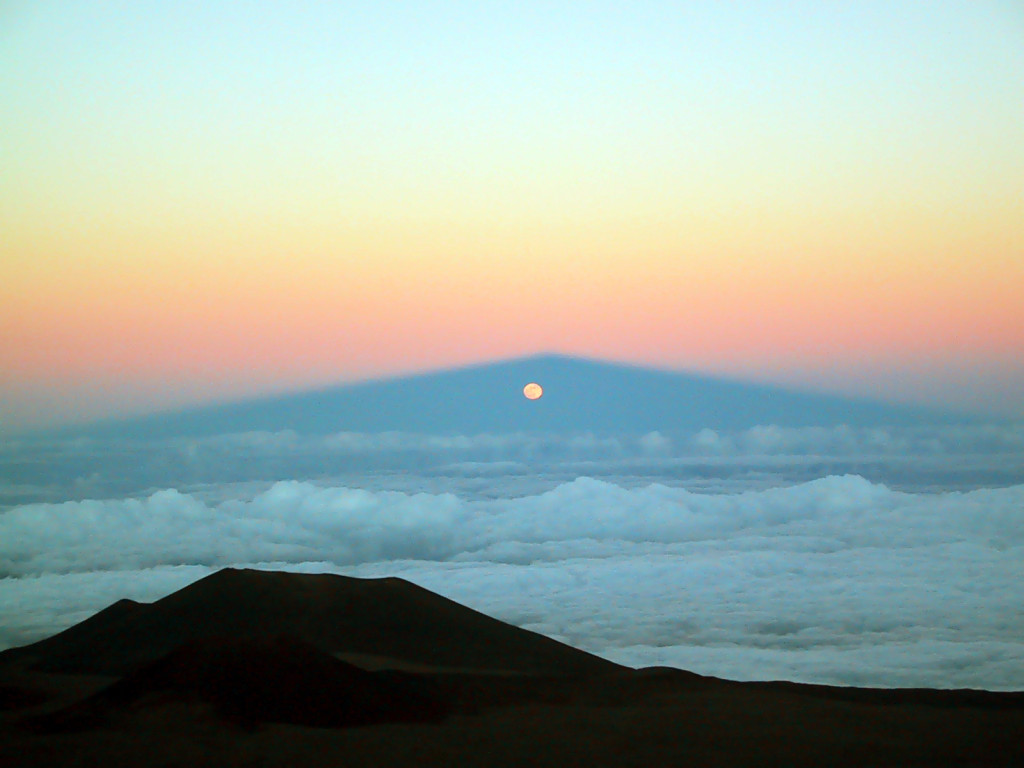
by DGR Colorado Plateau | Dec 6, 2015 | Lobbying
By Big Island Video News
MAUNA KEA, Hawaii – The permit allowing the Thirty Meter Telescope to be built and operated on Mauna Kea has been thrown out by the Hawaii Supreme Court.
In the conclusion of a 58 page opinion written by Chief Justice Mark E. Recktenwald, the court vacated the lower circuit court’s “May 5, 2014 Decision and Order Affirming Board of Land and Natural Resources, State of Hawaii’s Findings of Fact, Conclusions of Law and Decision and Order Granting Conservation District Use Permit for the Thirty Meter Telescope at the Mauna Kea Science Reserve Dated April 12, 2013, and final judgment thereon.” The Supreme Court remanded the matter to the circuit court “to further remand to BLNR for proceedings consistent with this opinion, so that a contested case hearing can be conducted before the Board or a new hearing officer, or for other proceedings consistent with this opinion.”
As many predicted after hearing the court’s questions during the oral arguments presented on August 27 (video below), the court found that the Board of Land and Natural Resources “acted improperly when it issued the permit prior to holding a contested case hearing.” The court says BLNR’s February 25, 2011 approval violated Hawaii’s constitutional guarantee of due process.
Read more at Big Island Video News, and at Nature.com. DGR member Will Falk worked on the Mauna Kea campaign and published a series of essays of the TMT project; you can find them at Deep Green Resistance Hawaii.
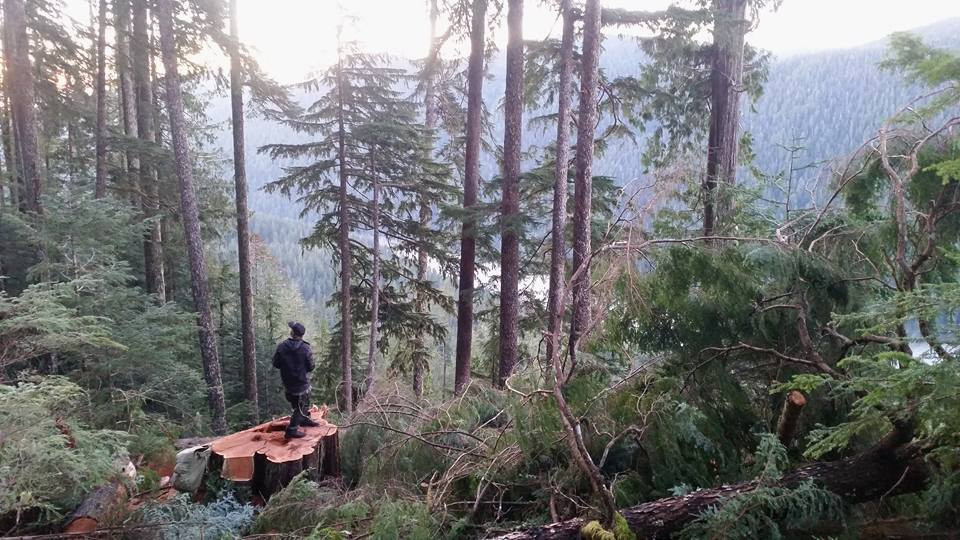
by DGR Colorado Plateau | Nov 28, 2015 | Biodiversity & Habitat Destruction, Lobbying
Editor’s Note: This letter, published at Vancouver Island Community Forest Action Network, is addressed to Canadian timber company Teal Jones Group in regards to the planned logging of Walbran Valley. You can read more about this at Renewed Defense of British Columbia’s Central Walbran Ancient Forest. Featured image of freshly cut cedar tree courtesy of Walbran Central.
By Zoe Blunt / Vancouver Island Community Forest Action Network
To Teal Jones’ executives, contractors, foresters, geologists, staff, and stakeholders:
I’m writing as a director of Vancouver Island Community Forest Action Network in Port Renfrew, BC. As forest watchdogs, we share Teal Jones’ goal of achieving the best environmental stewardship possible. I’m pleased to announce we are doubling down on our commitment to that goal.
There is a growing perception that Teal Jones’ operations in the Walbran Valley – logging an ancient forest that’s part of a beloved recreation area, on public land next to a park – is illegal, or ought to be. The public has a strong interest in ensuring that Teal Jones is not breaking any laws, statutes, or regulations.
In this spirit, we are recruiting volunteers to monitor every inch of area designated for timber harvesting, including proposed clearcuts, special management zones, wildlife habitat, leave trees, slash piles, streams, log dumps, roads, helipads, culverts, and ditches. We will check signage and radio frequencies, and visually inspect logging trucks. We will make sure the stumpage and grade-setting for the area are correct. A team of eager researchers is preparing for these tasks.
Of special concern are the karst features in the area – sensitive limestone formations underground, or in this case, on the surface. This is one of our areas of expertise, and we look forward to seeing the reports from the geologist responsible for signing off on logging those cutblocks. We plan to prepare our own reports and take all appropriate steps to ensure everyone involved is aware of the provisions of the law and fully complies with the requirements of the Forest District’s order for protection of karst.
There’s more. We will continue to follow up and document the area long after the trees are felled, to monitor reforestation, slope stabilization, road decommissioning, landslides, and habitat restoration.
We welcome the opportunity to use every legal means to achieve the goal of environmental sustainability.
We are aware of the history of violence by loggers in BC, including unprovoked attacks on peaceful protesters. We are concerned about potential hotheads on the logging crew, and for that reason we will take steps to keep our volunteers safe and give them the ability to respond appropriately, including documenting any violence or threats.
We note that rather than working with the community to find a way to preserve recreation sites and wildlife habitat, Teal Jones has taken the extreme step of suing people to get them out of the way.
Speaking for Forest Action Network, we have no intention of violating the court order. We employ strictly legal means to achieve our forest stewardship goals. Since the logging is taking place in a place designated as Crown land, we have the right and the responsibility as stakeholders to monitor and bear witness to Teal Jones’ operations.
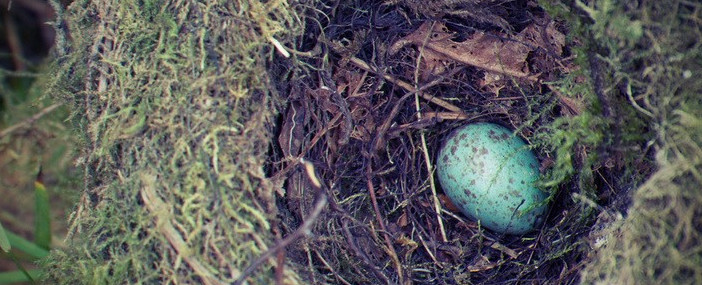
Thrush egg, Walbran Valley. Photo courtesy Ellen Atkin.
As a non-profit society, we don’t counsel anyone to commit illegal action. We don’t condone activities like sabotage, vandalizing equipment, or spiking trees, which is the practice of hammering oversized nails into trees to threaten chainsaws and mill blades. But we remember history: two thousand trees spiked in the Walbran Valley in 1992, for example. That kind of response is not what we advocate, but we recognize the potential is out of our control.
Teal Jones’ reckless pursuit of the ancient Walbran forest has brought us to this conflict in an effort to keep the peace. The company is aggressively logging up to the park boundary, disregarding community input, and failing to obtain social license for its operations in the Central Walbran. They are operating in a rapidly changing climate, using discredited practices from the last century. They have lost sight of the goal shared by millions around the world: preserving this dwindling, irreplaceable ecosystem. We will do everything in our power to sustain these living communities.
We’re looking forward to seeing you soon.
Sincerely,
Zoe Blunt
Vancouver Island Community Forest Action Network
#Walbran
Read Teal Jones’ lawsuit against environmentalists.
Read Teal Jones notice of application for an injunction.
Background info here.
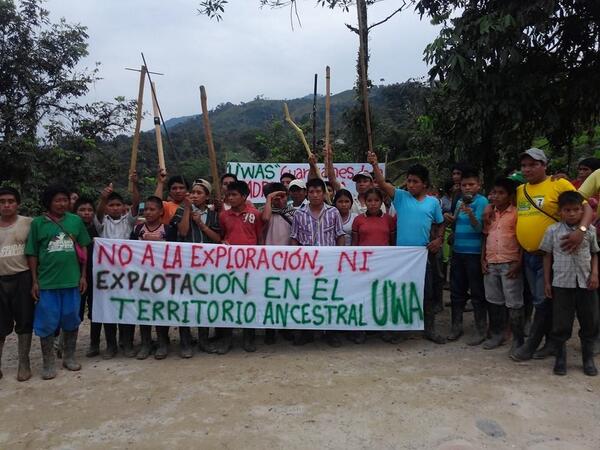
by DGR Colorado Plateau | Oct 21, 2015 | Indigenous Autonomy, Lobbying, Mining & Drilling
CASE ON INDIGENOUS LAND RIGHTS AND EXTRACTIVE PROJECTS MOVES FORWARD AT INTER-AMERICAN COMMISSION ON HUMAN RIGHTS
Washington, DC – The U’wa Nation has received an admissibility report by the Inter-American Commission on Human Rights allowing its case against Colombia to move forward, recognizing that the indigenous group can seek the Commission’s help in defending its traditional territory. Although the U’wa have successfully defeated multiple oil and gas projects in the nearly two decades since they first filed their complaint with the Commission, the report recognizes that winning these battles does not end the overall complaint with the Colombian government, which does not fully recognize the U’wa people’s rights to their territory.
In a statement released [on Oct. 16], The U’wa organization Asou’wa said: “Our U’wa Nation has been heard by the natural law, our ancestors and gods that guide and govern our thinking to safeguard, protect and care for our mother earth; While there are U’wa people, we will continue resisting in defense of our ancient rights.” EarthRights International (ERI) has been supporting Aura Tegria Cristancho, an U’wa lawyer who has been working on the case since 2013 from its offices in Lima, Peru, and Washington, DC.
Asou’wa, supported by the National Indigenous Organization of Colombia and the Coalition for Amazonian Peoples and Their Environment, first filed their complaint with the Commission in 1997. At the time, US-based Occidental Petroleum (Oxy) was threatening to drill for oil in their lands. The U’wa, supported by a global campaign against Oxy led by groups such as Amazon Watch and the Rainforest Action Network, secured Oxy’s withdrawal in 2001. More recently, Colombia’s Ecopetrol tried to move forward with a gas project on U’wa land, but pulled out earlier this year. However, U’wa’s title over their ancestral lands have not been yet recognized.
The Commission’s decision comes after the U’wa and their supporters made it clear that, despite these victories, the root of the problem is the government’s lack of recognition and protection of the indigenous group’s ancestral territory.
“With this decision, the Commission recognized that even though Oxy and Ecopetrol pulled out, the U’wa remain threatened by the failure to fully protect their homeland,” said Camila Mariño, a Colombian lawyer and legal fellow with EarthRights International. “We are proud to stand with the U’wa.”
In the decision, dated July 22 but only released [now], the Commission formally accepts the U’wa petition as “admissible.” According to the Commission’s website, only twelve cases have been accepted as admissible so far this year. Following this decision, the case will move to the “merits” stage, in which the Commission will rule on the rights violations at issue.
– 30 –
Contact:
Valentina Stackl
+1 (202) 466 5188 x 100
valentina@earthrights.org
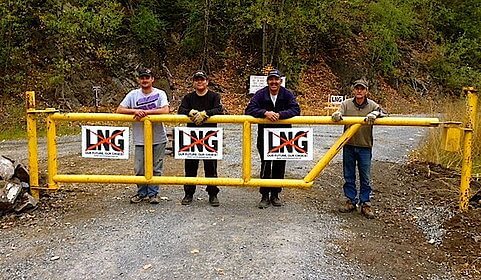
by DGR Colorado Plateau | Oct 18, 2015 | Indigenous Autonomy, Lobbying, Mining & Drilling
VANCOUVER – Luutkudziiwus, a Gitxsan Nation House Group, will file a legal challenge in regard to the BC regulatory permits awarded to the Prince Rupert Gas Transmission (PRGT) pipeline that would supply gas to the Petronas LNG plant on Lelu Island which threatens to decimate Skeena River wild salmon. Luutkudziiwus Hereditary Chiefs travelled down to Vancouver to make the announcement today, while government and industry are gathered at the 2015 LNG Conference in BC.
“We are taking the government to court over the lack of consultation, inadequate baseline information presented, a weak and subjective impact assessment, and the current cumulative effects from past development. People from all over northern BC are now outraged about the $40 billion Petronas LNG project. It is unbelievable that they claim they consulted with us,” says Luutkudziiwus spokesperson Richard Wright.
TransCanada’s proposed 900 km PRGT pipeline, contracted under Petronas, is slated to cross 34 km of Luutkudziiwus traditional Madii Lii territory on its way from massive fracking operations in Treaty 8 territory to the proposed Petronas-led (Pacific Northwest) LNG plant on Lelu Island in the Skeena estuary. Lelu Island is the tribal territory of the Gitwilgyoots of Lax Kw’alaams.
“Our Madii Lii territory is not to be played with by the province of BC in their LNG game. Clark’s LNG dream is a nightmare for us. While she tries to maintain a shiny picture of LNG in their conference this week, the reality is that First Nations are being bulldozed, and we have had enough,” says Hereditary Chief Luutkudziiwus (Charlie Wright).
Luutkudziiwus will ask BC Supreme Court to quash the Environmental Assessment Certificate and the BC Oil and Gas Commission permit to construct and operate the PRGT pipeline. These permits were not based on any substantive consultation, infringe upon Luutkudziiwus’ rights and title by allowing a pipeline which will cause adverse effects to fish and their habitats, wildlife and their habitats, terrestrial and aquatic resources, including cumulative effects, as well as to social, cultural, and economic values. In bringing their lawsuit, Luutkudziiwus is looking for consultation from BC government and will also ask the court to direct the Province of BC to consult with them before any permits are issued.
“The province has been stealing from our territory and culture for 150 years, and this needs to end. The proposed pipeline and LNG project is in deep conflict with core Luutkudziiwus interests and values,” said Hereditary Chief Xsim Wits’iin (Lester Moore).
“We want the BC government to respect our constitutionally protected Aboriginal rights with a true reconciliation process that honors healthy families and increases community health and education. Development within our traditional territories must have our Free, Prior and Informed Consent and stop tearing apart our communities” says Luutkudziiwus spokesperson Pansy Wright.
A delegation from Luutkudziiwus will be in Vancouver on Oct 14th, and will be available for interviews downtown or near the Vancouver Convention Centre on request.
– 30 –
For more information, photos, or to arrange interviews, please contact:
Richard Wright
Luutkudziiwus spokesperson
250.842.8974
richardwright_8@hotmail.com
Greg Horne
Media coordination
250 634 1021
Mary Macaulay
Legal Counsel
604 899 5227
mlmacauly@emlawyers.ca






